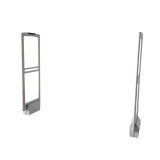In modern retail and inventory management, barcodes have long been the go-to technology for tracking products. However, a new player has emerged in recent years that promises to revolutionize the way we track and manage inventory – an RFID sticker. These innovative stickers utilize Radio Frequency Identification (RFID) technology to provide a more efficient and accurate tracking solution. In this article, we will delve into the world of RFID tag stickers and explore some innovative features that make them stand out from traditional barcodes.
What is an RFID Tag Sticker?

RFID tag stickers are small adhesive labels that contain an embedded RFID chip and antenna. Unlike barcodes, which require line-of-sight scanning, RFID tag stickers use radio waves to transmit data wirelessly. This enables bulk scanning and provides real-time visibility of inventory at a much faster pace. RFID tag stickers are commonly used in industries such as retail, logistics, healthcare, and manufacturing.
9 Benefits of an RFID tag sticker
1. Enhanced data storage
One of the key advantages of RFID tag stickers is their ability to store and transmit a large amount of data. Unlike traditional barcodes, which only hold limited information, RFID tag stickers can store unique product identifiers, batch numbers, expiration dates, and even product characteristics. This allows for better inventory management, traceability, and quality control.
2. Automatic identification and tracking
Gone are the days of manual scanning and data entry. With RFID tag stickers, the identification and tracking process becomes automated. By simply passing an RFID reader over a tagged item or using fixed readers at various checkpoints, businesses can quickly and accurately track their inventory in real-time. This saves time, reduces errors, and improves overall operational efficiency.
3. Improved asset visibility
Maintaining an accurate record of assets can be a challenge, especially in large warehouses or manufacturing facilities. RFID tag stickers offer a solution to this problem by providing improved asset visibility. By affixing RFID tag stickers to assets, businesses can track their location, movement, and usage patterns with ease. This helps prevent loss, enables efficient asset utilization, and streamlines maintenance processes.
4. Enhanced security features
RFID tag stickers come with a range of security features to protect against product counterfeiting and tampering. Unique identification codes can be encrypted within the RFID chip, making it difficult to replicate or alter. Additionally, some RFID tag stickers offer tamper-evident features, such as breakable circuits or adhesive seals, which alert businesses if an item has been tampered with during transit or storage.
5. Superior read range
Compared to barcodes, which require proximity and line-of-sight scanning, RFID tag stickers offer a superior read range. This means that multiple tagged items can be scanned simultaneously, without the need to physically locate and scan each tag. This significantly speeds up the inventory management process and allows businesses to conduct stocktakes more efficiently.
6. Enhanced supply chain visibility
RFID tag stickers enable businesses to gain valuable insights into their supply chain operations. By placing RFID readers at key points along the supply chain, companies can track the movement of goods in real-time. This helps identify bottlenecks, optimize logistics, and improve overall supply chain efficiency. With better visibility, businesses can make more informed decisions, reduce costs, and provide customers with accurate shipping updates.
7. Improved customer service
The use of RFID tag stickers can have a direct impact on customer service. By accurately tracking products throughout the entire supply chain, businesses can provide customers with real-time information about the availability and location of their orders. This reduces the chances of stockouts or delays and allows businesses to proactively address any issues that may arise. Ultimately, improved customer service leads to higher customer satisfaction and loyalty.
8. Enhanced security and anti-counterfeiting measures
RFID tag stickers offer enhanced security features that can help businesses combat counterfeiting and theft. The unique identifiers stored in RFID tags can be used to verify the authenticity of products throughout the supply chain. Additionally, businesses can set up EAS RF systems to detect any unauthorized movement of tagged items. This not only protects the company’s assets but also helps ensure the safety and satisfaction of customers who purchase their products.
9. Cost savings
While the initial investment in RFID technology may seem high, the long-term cost savings can be significant. The increased efficiency and accuracy provided by RFID tag stickers can lead to reduced labor costs, improved inventory management, and decreased losses due to theft or counterfeiting. RFID technology also allows for better utilization of resources and prevents overstocking or understocking of inventory. In the long run, these cost savings can make RFID tag stickers a worthwhile investment for businesses.
Conclusion
RFID tag stickers offer a range of benefits that can revolutionize the way businesses track and manage their inventory. From streamlined inventory management processes to improved supply chain visibility and enhanced customer service, RFID tag stickers provide a more efficient and accurate solution compared to traditional barcodes. Additionally, their enhanced security features and potential cost savings make them a valuable investment for businesses in various industries. With the continued advancements in RFID technology, we can expect to see even more innovative applications of RFID tag stickers in the future.
FAQs
1. What is the purpose of an RFID sticker?
RFID stickers serve the purpose of wirelessly transmitting data using radio frequency identification technology. These stickers contain a unique identifier that can be read by RFID readers, enabling quick and efficient tracking of items, access control, and inventory management. They are commonly used in logistics, retail, and security applications to streamline processes and enhance overall efficiency.
2. What you should know about RFID tags?
RFID tags are electronic devices that use radio frequency identification technology to store and transmit data. They consist of a microchip and an antenna, enabling wireless communication with RFID readers. Key points to know include their use for tracking and identifying items, applications in logistics and inventory management, and the ability to store varying amounts of data.
RFID tags come in different types, such as passive (powered by RFID reader signals) and active (self-powered). Understanding their capabilities and limitations is essential for effective implementation in sectors like supply chain, retail, and access control.
3. Why are RFID tags good?
RFID tags offer several advantages. They enable efficient and accurate tracking of items, leading to improved inventory management. Their wireless nature allows for quick data transmission, reducing the time required for tasks like asset identification and access control. RFID technology enhances automation, streamlining processes and minimizing errors.
The tags are durable, versatile, and can store various types of data, contributing to their widespread use in logistics, retail, and security applications. Additionally, RFID tags are cost-effective over the long term, offering a reliable solution for businesses seeking enhanced efficiency and productivity.
4. How do RFID tags prevent theft?
RFID tags help prevent theft by improving security measures. They enable real-time tracking and monitoring of items, making it harder for thieves to go unnoticed. In retail, for example, RFID-enabled anti-theft systems can trigger alarms if tagged items exit without proper authorization. The technology enhances visibility, discouraging theft attempts.
Additionally, RFID aids in inventory accuracy, reducing the likelihood of discrepancies that may be exploited by thieves. The ability to link RFID data with security systems provides a proactive approach, deterring theft and aiding in the quick recovery of stolen items. Overall, RFID’s real-time tracking and monitoring capabilities contribute significantly to theft prevention strategies.


































